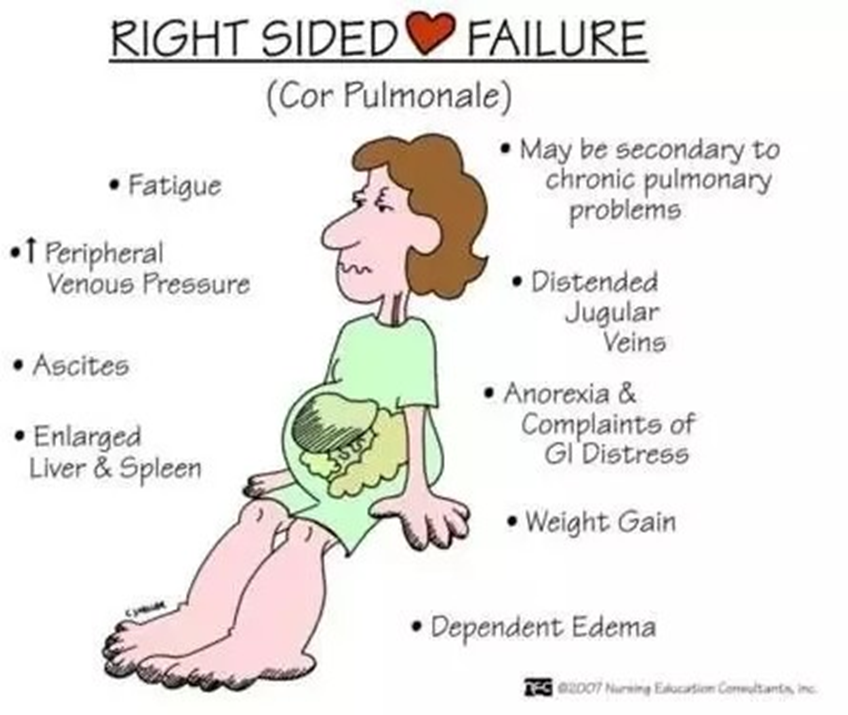In the context of a 65-year-old male patient diagnosed with chronic pulmonary disease and elevated pulmonary vascular resistance, which type of heart failure should the nurse assess for in this patient?
High-output heart failure.
Low-output heart failure.
Left heart failure.
Right heart failure.
The Correct Answer is D
Choice A rationale
High-output heart failure is not typically associated with chronic pulmonary disease and elevated pulmonary vascular resistance. High-output heart failure occurs when the heart is unable to meet the body’s increased demand for blood flow, which is not the case in this scenario.
Choice B rationale
Low-output heart failure is also not typically associated with chronic pulmonary disease and elevated pulmonary vascular resistance. Low-output heart failure occurs when the heart is unable to pump enough blood to meet the body’s needs, which is not the case in this scenario.
Choice C rationale
Left heart failure is not typically associated with chronic pulmonary disease and elevated pulmonary vascular resistance. Left heart failure occurs when the left side of the heart is unable to pump enough blood to the body, which is not the case in this scenario.
Choice D rationale
Right heart failure is the correct answer. In the context of a 65-year-old male patient diagnosed with chronic pulmonary disease and elevated pulmonary vascular resistance, the nurse should assess for right heart failure. This is because the right side of the heart pumps blood to the lungs, and if the pulmonary vascular resistance is elevated, it can put strain on the right side of the heart, leading to right heart failure.

Nursing Test Bank
Naxlex Comprehensive Predictor Exams
Related Questions
Correct Answer is C
Explanation
Choice A rationale
Furosemide (Lasix) is a diuretic often used in the treatment of pulmonary edema to help remove excess fluid from the body. While it’s important to monitor the patient’s fluid and electrolyte balance, it’s not typically necessary to question this medication.
Choice B rationale
Captopril (Capoten) is an ACE inhibitor used to treat conditions like heart failure and high blood pressure. It can be beneficial in managing pulmonary edema by reducing the workload on the heart. It’s not typically necessary to question this medication.
Choice C rationale
Digoxin (Lanoxin) is a medication used to treat heart failure and atrial fibrillation. It’s important to question this medication before administration because digoxin has a narrow therapeutic index, meaning the difference between a therapeutic dose and a toxic dose is small. Therefore, it’s crucial to ensure the patient’s digoxin levels are within the therapeutic range before administering more of the medication.
Choice D rationale
Carvedilol (Coreg) is a beta-blocker used to treat high blood pressure and heart failure. While it’s important to monitor the patient’s blood pressure and heart rate, it’s not typically necessary to question this medication.
Correct Answer is D
Explanation
Choice A rationale
Iron supplements for anemia do not typically interact with warfarin (Coumadin). Iron is a mineral that is essential for the production of red blood cells, and supplements are often prescribed to patients with anemia to increase their iron levels. While it’s important for healthcare providers to be aware of all medications and supplements a patient is taking, iron supplements are not known to diminish the effects of warfarin.
Choice B rationale
Furosemide (Lasix) is a diuretic medication used to treat fluid retention. It works by causing the kidneys to get rid of unneeded water and salt from the body into the urine. While furosemide can interact with other medications, it is not known to diminish the effects of warfarin.
Choice C rationale
Simvastatin (Zocor) is a medication used to control cholesterol levels. It works by slowing the production of cholesterol in the body to decrease the amount of cholesterol that may build up on the walls of the arteries and block blood flow to the heart, brain, and other parts of the body. Simvastatin does not typically interact with warfarin to diminish its effects.
Choice D rationale
Yaz (drospirenone/estradiol) is an oral contraceptive that contains estrogen. Estrogen can potentially increase the effects of warfarin, leading to an increased risk of bleeding. Therefore, if a patient taking warfarin also takes Yaz, it could potentially diminish the effects of warfarin, making it less effective. This is why it’s important for healthcare providers to be aware of all medications a patient is taking, including oral contraceptives.
Whether you are a student looking to ace your exams or a practicing nurse seeking to enhance your expertise , our nursing education contents will empower you with the confidence and competence to make a difference in the lives of patients and become a respected leader in the healthcare field.
Visit Naxlex, invest in your future and unlock endless possibilities with our unparalleled nursing education contents today
Report Wrong Answer on the Current Question
Do you disagree with the answer? If yes, what is your expected answer? Explain.
Kindly be descriptive with the issue you are facing.
